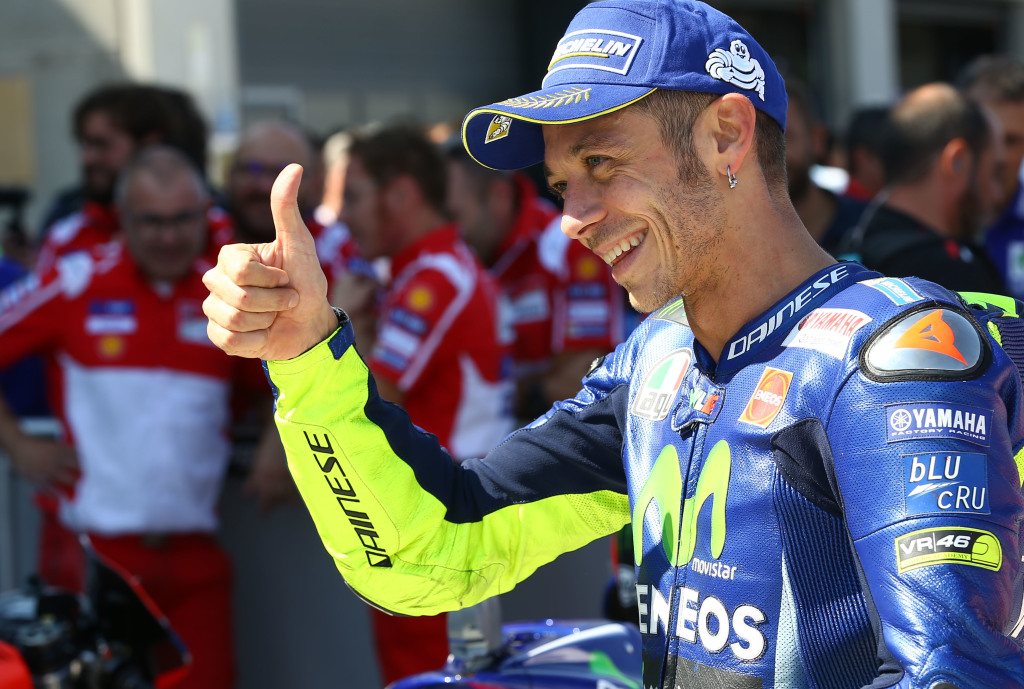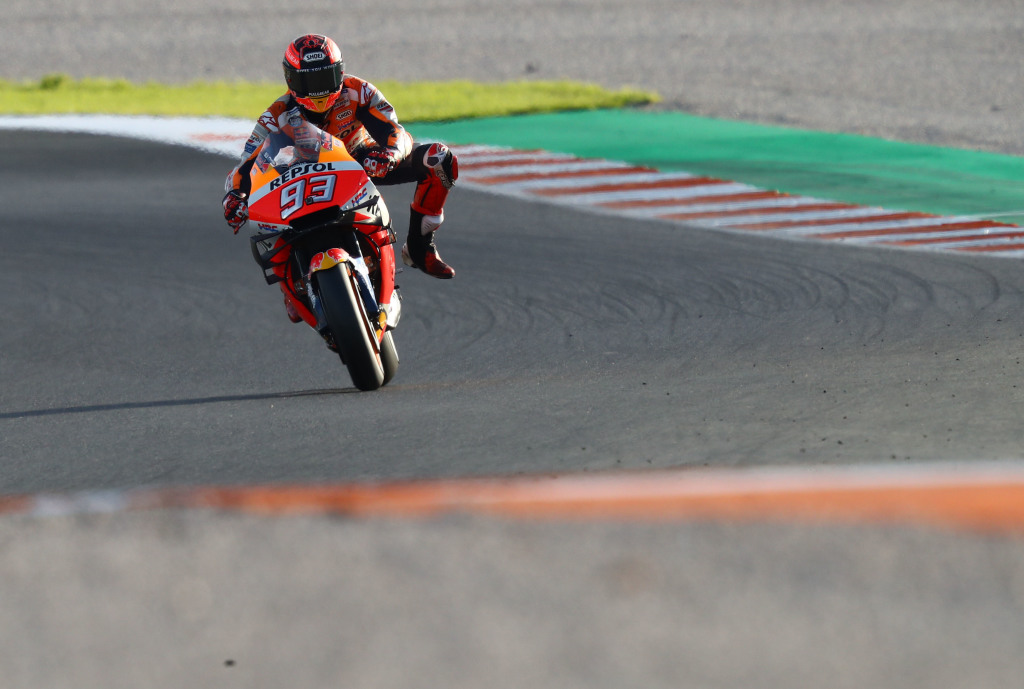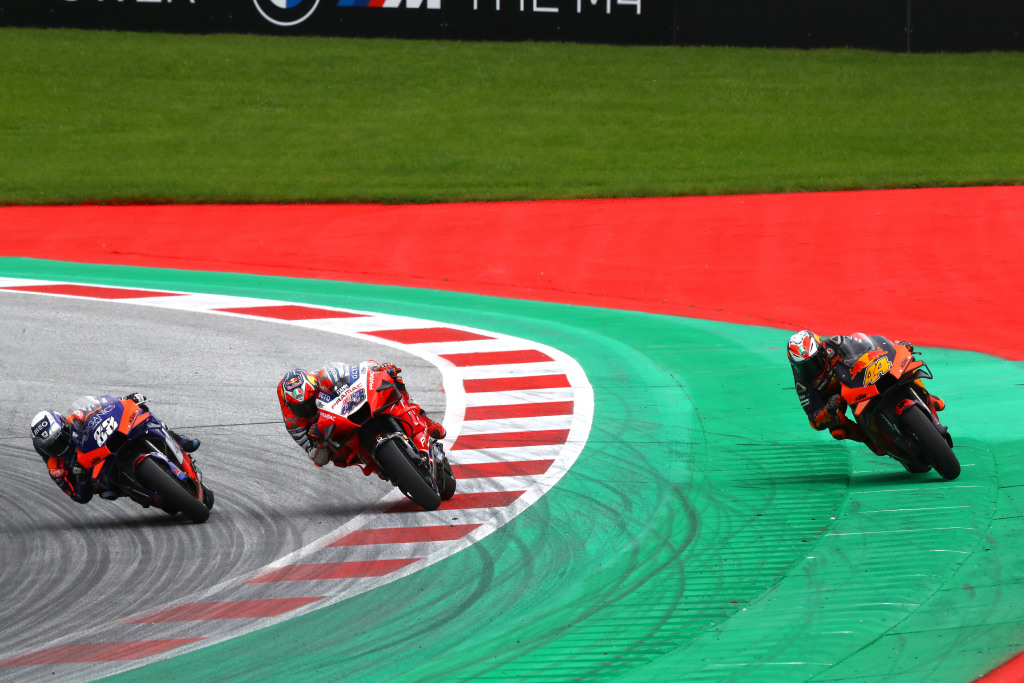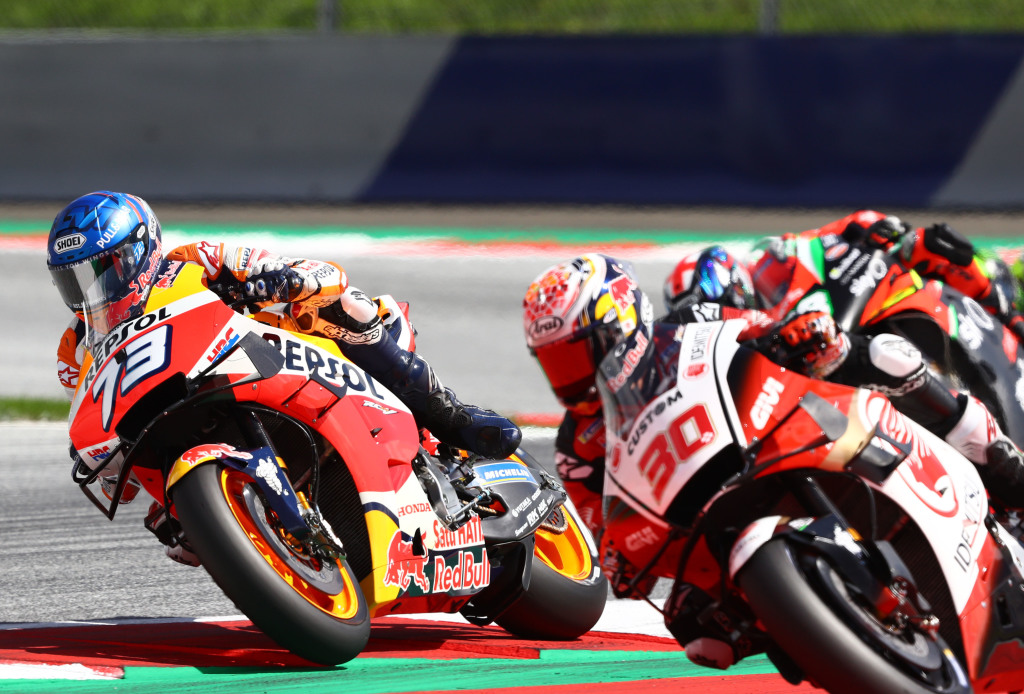MotoGP bikes may have half the wheels F1 cars have, but that doesn’t make the racing any less exciting.
There’s plenty to get revved up about in MotoGP, and if you’re a fan of F1, there’s not much to pick up. While there are new teams, riders, constructors and rules to get used to, there are also some awesome tracks across the world to learn and visit.
In this guide, we look at MotoGP from a Formula 1 fan’s point-of-view. If you’ve ever wanted to get into motorcycle racing and need to know the basics, this is the place to start. You’ll learn about the tracks, the riders, the bikes, the format and more. And we’ll contextualise everything to Formula 1, which should help you along the way.
Read on, and we’ll see you trackside at the next race.
Who are the big teams?
Unlike in Formula 1, constructors and teams are very different. A constructor is akin to engine manufacturers in F1. They build the bikes that each team then uses. There are currently six constructors in MotoGP: Yamaha, Ducati, Suzuki, Aprilla, KTM and Honda. The most successful constructor in the premier class of MotoGP is Honda, which has supplied the bike winning the championship on 25 occasions. Honda won 8 of the 9 championships between 2011 and 2019, with only Yamaha the other team to win in 2015. Italian constructor Ducati won its second championship ever in 2020.
The bikes are then used by different teams. There are factory teams, and satellite teams. The factory teams are directly managed and funded by the constructor, similar to how Ferrari, Mercedes and Renault produce engines and run teams in Formula 1.
There are six factory teams in MotoGP: Ducati Team, Monster Energy Yamaha MotoGP, Red Bull KTM Factory Racing, Repsol Honda Team, Aprilia Racing Team Gresini and Team SUZUKI ECSTAR.
There are then five satellite teams: Esponsorama Racing, Petronas Yamaha SRT, Red Bull KTM Tech 3, LCR Honda and Pramac Racing. Some of these satellite teams have access to up-to-date factory bikes, such as Pramac Ducati & Red Bull KTM Tech 3 in 2020. However, some teams such as LCR Honda and Petronas Yamaha SRT were only given one up-to-date bike for one rider.

Copyright: Gold and Goose / LAT Images
Who are the riders I should know about?
If the 2020 season is anything to judge, all of them.
Valentino Rossi is a household name of motorsport. Affectionately known as ‘The Doctor’, the Italian started riding in 2000 and has started 354 races, winning 7 world championships along the way. His relaxed, fun-loving attitude off-the-track, and dominance on it made him a favourite for many – including McLaren’s Lando Norris, who has been seen wearing his merch in the F1 pit lane.
Over the last decade, however, MotoGP has been dominated by Spaniard Marc Marquez. Debuting in 2013, he won the title in every season he’s competed in bar two: 2015 and 2020. The latter was a result of a broken arm forcing him out of action for most of the COVID-affected year, but that opened the door for a number of new names to come to the forefront.

Image copyright: Motorsport Images
Joan Mir, Franco Morbideli, Fabio Quartararo, Brad Binder, and Miguel Oliveira each won a race for the first time in 2020, with Andrea Dovizioso, Alex Rins, Maverick Viñales and Danilo Petrucci rounding off a huge nine different winners in one season.
Mir took the championship. In just his second season, he scored seven podiums and his maiden win to secure the riders’ trophy by 13 points.
Where in the world does MotoGP race?
MotoGP races all across the world. It usually kicks off in Qatar, with races in North and South America, Asia and Australia, however most races take place in Europe.
For F1 fans, there are a number of circuits you might recognise: the Austrian GP takes place at the Red Bull Ring, the US race is at Circuit of the Americas, the British race is at Silverstone, and the Italian race takes place in Mugello, where F1 raced for the first time in 2020.
However, there are some fantastic circuits elsewhere in the world that are must-see races. The Dutch race known as the TT Assen is a staple race that’s always full of action, and the challenging Australian race on Philip Island is a breathtaking circuit.
You’ll also notice a number of races in Spain. MotoGP and motorcycle racing is huge in Spain. There are a number of Spanish riders: Marquez, Vinales, Mir, Rins, Lorenzo to name a few. And their popularity has led to a number of Spanish cities hosting races, such as Jerez, Barcelona, Aragon and Valencia.
Is MotoGP qualifying different to F1 qualifying?
Very. In MotoGP, the free practice sessions – of which there are three – are all-important. From the free practice sessions, the 10 quickest riders will enter Q2 with the remaining 12 heading into Q1. Q1 will decide the order for the final 10 spots on the grid, and the two fastest riders move up into Q2 to battle for pole. In Q2, 12 riders race to set the fastest times and set the top four rows on the grid – as each row consists of three bikes.
How long do the races last?
As a rule, Formula 1 races cover 305km, and the number of laps reflects that. That’s why the Austrian Grand Prix at the Red Bull Ring (4.3km) has 71 laps, and the Belgian Grand Prix at Spa (7km) has 44 laps.
In MotoGP, the minimum race distance to cover is 95km and the maximum is 130km. This means the races usually last 45 minutes.

Image copyright: Motorsport Images
What’s the key to a MotoGP race strategy?
Unlike in Formula 1, strategy doesn’t really play a big part MotoGP. When the lights go out, it’s usually up to the riders’ styles. Some will go all-out from the start to build up a gap, others might hold back and unleash some extra power later in the race. This makes setting up the bike vital, as there’s no opportunity to change anything on the bike once it’s left the garage.
That includes tyres, which are crucial to race styles. Like F1, there are three compounds: soft, medium and hard. However, the front and rear tyres can be mixed-and-matched. Meaning some riders could opt for a soft-front and soft-rear, but others might go for a soft-front and medium-rear. This choice will be dictated by the track surface, how quickly the tyres are degrading, and riding style. The only way to change the tyres is to come into the pits and swap bikes. While this is quite rare, a well-timed bike change can make all the difference.
Are there any pitstops?
Typically, no. A rider will use the same bike and tyres for the duration of the entire race.
However, there are important exceptions. A flag-to-flag race is a race that may start in dry conditions, but as rain starts to fall, riders are permitted to enter the pits and swap bikes for one with suitable tyres for the damp track. Teams are permitted to bring multiple bikes to each race, so swapping bikes is easier than changing tyres.
What are Moto2, Moto3 and MotoE?
They are very similar to their open-wheel racing counterparts: F2, F3 and Formula E. MotoGP is the premier class of motorcycle racing, and the engines are 1000cc V4s. The Moto2 class is slightly smaller at 765cc inline-three, and Moto3 is 250cc single-cylinder.
The MotoE World Cup was introduced in 2019, and features electric bikes. These bikes have a max power of 120 kW, and can reach speeds of 270km/h and can accelerate from 0-60mph in 3 seconds.
For comparison, here are the pole times set by the four classes at the 2020 French Grand Prix:
| Class | Rider | Time |
| MotoGP | Fabio Quartararo | 1:31.315 |
| Moto2 | Joe Roberts | 1:36.256 |
| Moto3 | Juame Masia | 1:41.399 |
| MotoE | Jordi Torres | 1:43.853 |
What is the atmosphere like at a race?
The atmosphere at a MotoGP race is mega. Fans of the sport are as passionate – if not more so – as Formula 1 fans. At many circuits, you’ll find grandstands dedicated to certain drivers such as Rossi or Marquez. In Austria, there are two grandstands dedicated to Valentino Rossi, click here to find out more.
There’s plenty of racing action on track to enjoy from the support categories, and entertainment away from the circuit usually includes concerts, manufacturer areas and VIP experiences.
